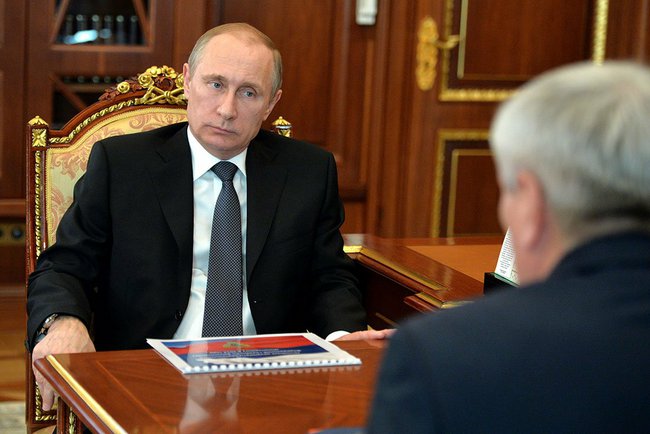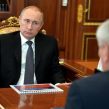
The Kremlin’s Game of Threats
Publication: Eurasia Daily Monitor Volume: 12 Issue: 56
By:

Last week (March 19), speaking at an annual conference of the Union of Russian Industrialists and Entrepreneurs (RSPP)—Russia’s main business lobbying group—President Vladimir Putin promoted a previously announced financial amnesty. Putin implied that Russia’s super-rich must repatriate their capital back from abroad and out of offshore havens to legalize them in Russia with impunity. A mass repatriation of capital could help overcome the present Russian economic and financial doldrums, caused by a steep decline in the price of oil and other export commodities, the Ukrainian conflict, and Western punitive sanctions. To force the repatriation of secret multi-billion-dollar deposits stashed away for a rainy day, Putin implied Russian money abroad is unsafe and could be confiscated by foreign governments: “We have information that the possible return of capital to Russia may be prevented.” Behind closed doors, President Putin, reportedly, briefed a select group of 30 of Russia’s most powerful oligarchs about the present situation in Ukraine and deliberated about the presumed threat to their capital abroad. The oligarchs were, apparently, upset (Kommersant, March 20).
This past Monday (March 23), Putin met with Yuri Chikhanchin, the chief of Rosfinmonitoring—Russia’s federal service that monitors illicit financial activities. In the published part of the meeting, Putin implied the West “is creating pretexts to stop the return of financial resources into Russia.” Chikhanchin concurred, quoting British investigations of the legality of Russian citizens’ bank accounts as well as the possibility of further criminal investigations and asset freezes. The Rosfinmonitoring chief also called on citizens “not to wait, but return the capital [to Russia]” (Kremlin.ru, March 23).
The Kremlin may be using blackmail to scare Russian oligarchs into repatriating capital, but Moscow’s escalating confrontation with the West is not a deception. On March 26, speaking at the annual collegium of the Federal Security Service (FSB), Putin harped about the growing international tension “caused by our so-called partners.” Putin accused the North Atlantic Treaty Organization (NATO) of massing forces and building military infrastructure close to Russia’s borders and the United States of destabilizing international security and attempting to disrupt the nuclear balance. Russia is being “contained, using attempts of political isolation, economic pressure, a massive information war and special services operations.” He continued, “Western special services are attempting to destabilize Russia internally using non-governmental and civil society organizations.” Russia must fight back and be strong. In “special operations” in 2014, according to Putin, “the FSB has curtailed the activities of 52 foreign spies and 290 agents of foreign special services [Russians, recruited by foreign spies]” (Kremlin.ru, March 26).
The Russian Security Council produced this week (March 25) its official analysis of the US National Security Strategy (published last February). The new Strategy, unlike the previous 2010 version, has been declared to be “clearly anti-Russian” and threatening: “The US and its allies are attempting long-term political and economic isolation of Russia, to curb Russian oil, gas and arms exports, while sabotaging high-tech internal production. The US and its allies are trying to undermine Russian influence in the post-Soviet space.” The US and NATO are “striving to sustain world dominance,” while preparing “new colored revolutions to change unwanted regimes.” It is “highly probable that the technologies of a colored revolution [sic]” will be used in Russia (Scrf.gov.ru, March 25).
Surrounded by enemies, real or imaginary, the Kremlin is pushing back. Last week’s massive “sudden” military exercises (“vnezapnaya proverka”) have ended and have been officially called a success (see EDM, March 19). All foreign military attaches accredited in Moscow (over a hundred) were called, on March 21, for a high-level briefing to the newly built National Defense Management Center (NTsUO) on the Moscow River’s Frunzenskaya embankment, close to Moscow’s downtown. Russian Deputy Defense Minister Anatoly Antonov and the chief of the Main Operational Directorate and deputy chief of the General Staff, Lieutenant-General Andrei Kartapolov, asked the military attaches “not to panic” and to report to their capitals: “Russia does not want war,” but to prevent it, it “will need a modern, effective, well-equipped armed force.” The NTsUO is designed to control, in real time, Russia’s nuclear and conventional armed forces; Antonov implied it was a gesture of great transparency to invite inside foreign military attaches. Of course, the new NTsUO facility houses an array of grandiose halls with massive plasma screen monitors that are open to the press and used for PR occasions. These monitors in the room were used to show the attaches footage of the recent “sudden” exercises. As Kartapolov explained: The war games began with the North Fleet in the Barents Sea and surrounding region on air, land and sea; then the simulated conflict spread to include the Baltic, the Black Sea, Crimea and Sakhalin in the Far East (Mil.ru, March 21).
Clearly, for Russia, a conflict on all those fronts simultaneously could only be against the United States and its allies. Russia’s threat assessment, as outlined by Kartapolov and by the defense minister, Army-General Sergei Shoigu, who this week briefed Putin in the Kremlin together with the chief of the General Staff, Army-General Valery Gerasimov, is focused on the US and its allies attacking and capturing outlying Russian isolated outposts and islands. Additional reinforcements were landed on Sakhalin, while Russian strategic bombers, escorted by fighters, attacked targets in the Asia-Pacific region. The 11th Engineering Brigade prepared to build a floating bridge across the Kerch Strait into Crimea, while the Black Sea Fleet and bombers from Crimea attacked the Bosporus region to destroy enemy ships. The destruction of a US strategic high-altitude Global Hawk spy drone was mimicked in the Black Sea. An overall massive force of 80,000 soldiers, 12,000 pieces of heavy military equipment, 65 war ships, 15 submarines and over 220 military aircraft were mobilized to action. The NTsUO coordinated all the forces, conventional and strategic nuclear, across all war theaters. The “main enemy,” according to Shoigu, was defeated, and its ships were sunk in all theaters (Kremlin.ru, March 24).
The Kremlin is mobilizing military forces and oligarch money for a clash with Russia’s “main enemy,” apparently presuming a possible further escalation of conflict with the US and its allies. At the same time increased measures of openness about the details of the “sudden” exercises and the possible freeze of Russian assets in the Western banking system seem intended to spread fear, discourage opponents, and create discord. The threat of a more acute confrontation with the West is real, but it is also being deliberately amplified by the Kremlin as a tool for blackmail.




